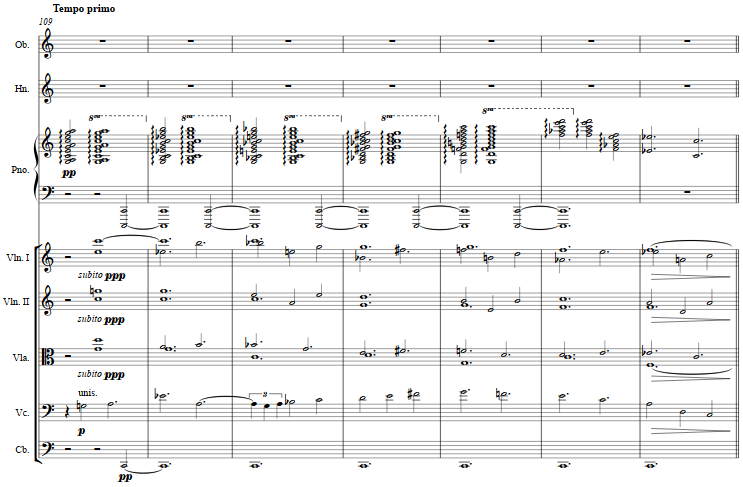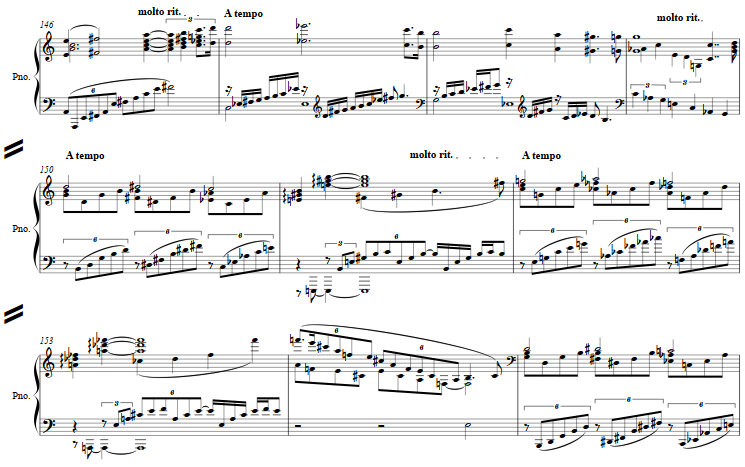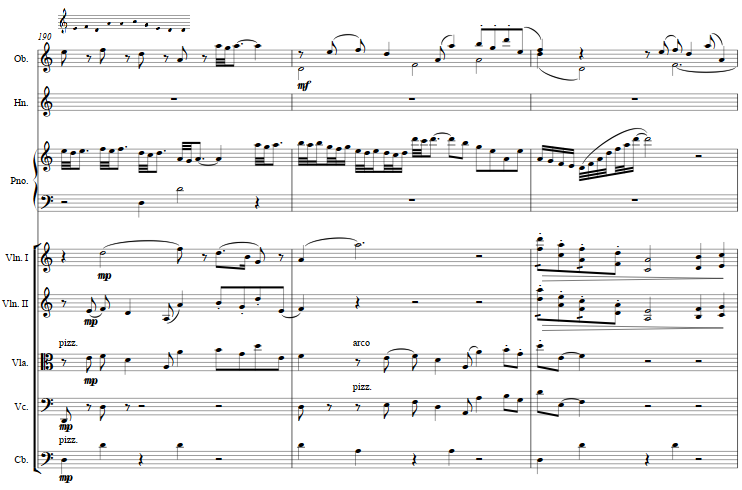Music and Texts of GARY BACHLUND
Vocal Music | Piano | Organ | Chamber Music | Orchestral | Articles and Commentary | Poems and Stories | Miscellany | FAQs
Concerto in C for Piano and Orchestra - (2017)
The motives on which this work is based a drawn from musical cryptograms, as one finds in part in the Concerto in D flat for Piano and Chamber Orchestra
The three here represent in a series of notes the composers, Schoenberg, Shostakovich and Stravinsky, the first two cryptograms having been used before, and the last generated through another method. [ 1 ]
The work opens with solo piano, parallel triads in first inversion referring to the Schoenberg cipher. The resultant harmonic complexities blur together into a Klang for this section. These gestures are then taken up in divisi strings.

The orchestra restates the theme, and then breaks into a rhythmic dance-like section in the overall 3/2 notation also citing "Schoenberg", the first two beats tango-like with the last a triplet to break the dance rhythm.
Among the episodes as the first kernel plays itself out, a quiet moment of clustered string harmonies is decorated with arpeggios of many notes.
A restatement of the fist section's themes plays out, and is interrupted by the square, forceful statement of the second cryptogram. Less developed than the first, the orchestra repeats with marcato. The citation of the next cryptogram in noted in the full score.
A break from the from the orchestra textures is made, as the solo piano takes center stage elaborating on the "Shostakovich" four-note kernel across many harmonic domains.
The third section cites "Stravinsky" in its cryptogram as noted in the score, as the orchestra's many contrapuntal lines and notated embellishments in the piano refer lightly to a neo-Baroque foreground texture.
The work ends as the piano and orchestra unite in a recapitulation of the first section's dance-like strut alongside references to the following sections as episodic materials.
68 pages, circa 19'00" - an MP3 emulation of the work is here:
The score and parts are available as a free PDF download, though any major commercial performance or recording of the work is prohibited without prior arrangement with the composer. Click on the graphic below for this score.
Concerto in C for Piano and Chamber Orchestra
NOTES
[ 1 ] The three cryptograms in order of use are:


Of such, one reads: "A musical cryptogram is a cryptogrammatic sequence of musical notes, a sequence which can be taken to refer to an extra-musical text by some 'logical' relationship, usually between note names and letters." Also "[A], E♭, C, B♮, B♭, E(♮), G (= [A], S, C, H, B, E, G) for Arnold Schoenberg (A. Schönberg),[13] set 6-Z44," D," E♭, C, B (= D, S, C, H) for Dmitri Shostakovich (D. Schostakowitsch)" (from "Musical Cryptogram," Wikipedia article, n. d. The last is a simple substitution done in Java script, and not referring to tradition uses for such cryptograms, via an entertaining online generator created by Mike Su at CodePen
. In other works, I have used other musical cryptograms which more closely align with that "naming" tradition as can be seen even beyond Maurice Duruflé's tribute to a friend and colleague.
Graphics of the associated cryptograms for this work "title-in-picture" each section as they appear in a first statement.
In addition to cryptograms which have generated other works, sometimes a theme thought about after attending a performance of rehearsal sparks musical thought. As regards both the dedicatee but also composers, other such works notably for organ include a Little Fugue on the Scala enigmatica
after a rehearsal of Verdi's Ave Maria (from the Quattro Pezzi Sacri) at Berlin's Philharmonie, a Contrapunctus on a Theme of Wagner
after a 2015 performance of Die Meistersinger at the Staatsoper thinking on the quote from the third act, as well as the Variations and Fugue on a Theme of Webern
, after a 2012 performance of Webern's Passacaglia by the Staatskapelle under Barenboim.





